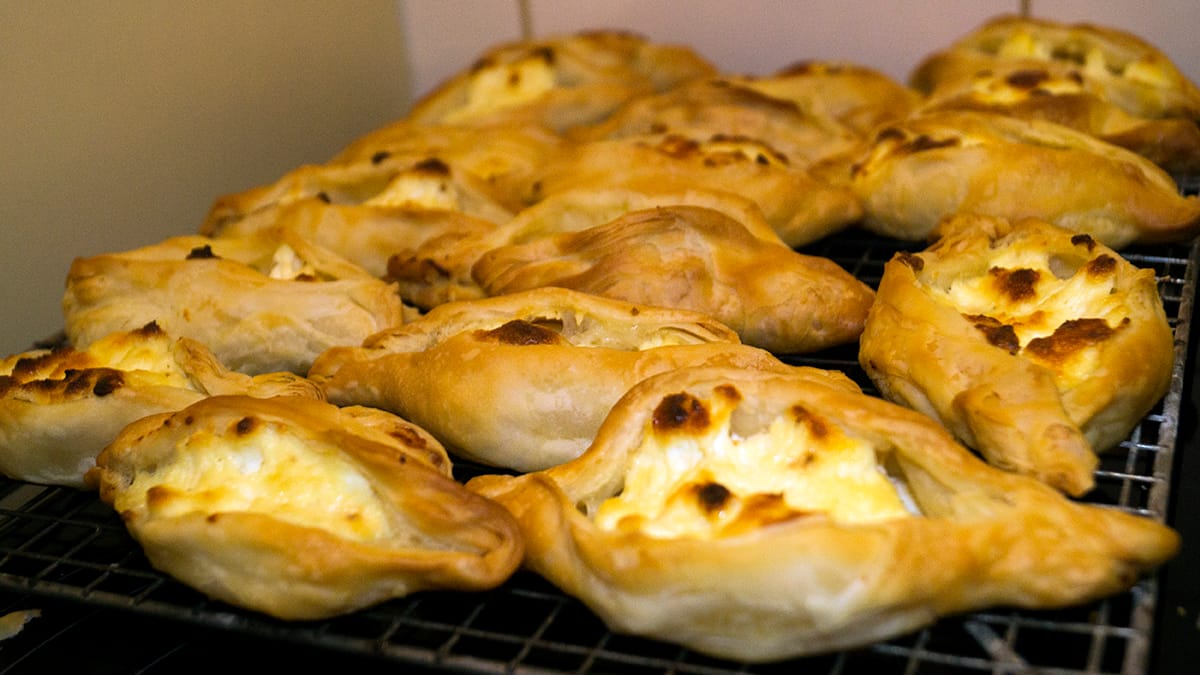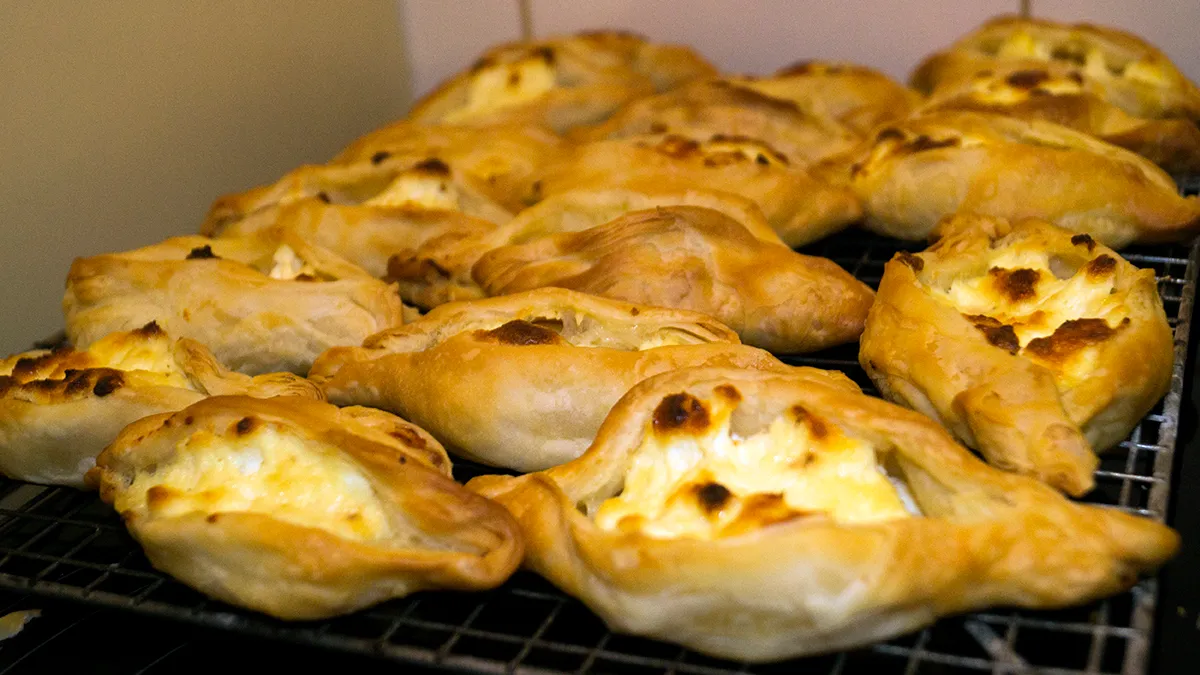When it comes to Maltese food, pastizzi are essential. These succulent parcels of crisp, golden, filo-like pastry are the signature Maltese snack, sold as street food and indispensible at family gatherings. There is really nothing else quite like them: spanakopita are perhaps the closest, but pastizzi are in a class of their own.
Traditionally filled with either ricotta or a mildly curried mashed-pea mix, today pastizzi are sold with a variety of fillings, even sweets. Commercial versions are available frozen, but, apart from some smaller suppliers in large Maltese diaspora cities like Melbourne or Sydney, the commercial variety are pretty dire.
So, make your own! Be warned, though, that making pastizzi is a long process. Uncooked pastizzi freeze perfectly. Just take them out and bung them in the oven. This recipe will make about 50 pastizzi, which may sound like a lot, but you’ll be astonished at how fast they vanish.
With that in mind, at least double, if not triple, the recipe. Get the family around the kitchen bench to do the final filling and shaping. It makes the job go faster and is a great family bonding moment.
For the pastryIngredients:
- 1 kg plain flour
- 2 cups+ of cold water
- 1 tsp salt
- 250g cooking margarine (butter or ordinary margarine will suffice, though)
- Olive oil
Method:
This is a complicated process, so watch the video at the end, which goes through it all step by step.
Either by hand or in a mixer with a dough hook, mix the flour, salt and water, to make a firm dough. Once mixed, knead by hand into a ball for about 3 minutes. Wrap in cling film and rest for half an hour.
Now comes the tedious stuff. The whole point of pastizzi dough is to continually roll, stretch and pull the dough, while adding layers of shortening. Roll the dough into a rough oblong, about 40–50cm (15″–20″) long, and about 15–20cm (6″–8″) wide. Rub the cold block of shortening all over, coating it with a thin amount.
Fold the dough in half, and rub with shortening again.
Fold it in half again, then roll it out the other way and repeat the process. Fold, rub and roll about 6 to 10 times. (It’s a good workout for the arms. My wife’s little old aunt used to make her own pastizzi all the time – how she didn’t have biceps like Popeye is beyond me.)
Once done, wrap in cling film again and rest for 2 hours. You can rest it at room temperature on the bench, unless it’s a particularly warm day; in which case, put it in the fridge.
You’ll need plenty of bench space for the next bit. If your bench isn’t long enough, do the dough in 2 halves.
Roll, stretch, and pull the dough out as thin as possible, without tearing (you’ll no doubt get a few tears, but don’t sweat it too much). In the end, the dough should be practically paper-thin, and a little transparent.
Spread the remaining shortening over the dough (if you do the dough in halves, halve the shortening for each piece). You’ll find the dough is slathered fairly thickly, but, hey, we’re not making health food here. Keep a little piece of shortening aside.
Now, carefully roll the dough up, like rolling a sheet of paper. As you roll it, pick it up and stretch it out a little more, if you can. Roll it into a nice, tight ‘snake’ about 8cm (3″) thick. Rub the last of the shortening all over, wrap in cling film again, and refrigerate for at least two hours, or even overnight.
After the dough has rested, unwrap it and pull and stretch the dough lengthways until its about half its thickness: about 4cm (1 3/4″). Cut the dough into roughly 4cm pieces. It can be easier if you coil the dough up on the bench, and unravel it as you cut the pieces off.
This is the bit where having lots of helpers really speeds up the process. Have a little bowl of olive oil standing by to dip your thumb and forefinger tip into. Pick up a piece of dough and press your thumbs into the centre of the crosswise section (you’ll see all those all-important layers of pastry, like tree rings). Spread and stretch the dough into a flat disc about 10cm (4″) across.
Lay the disc along the top of your outstretched thumb and forefinger and fold a little to make a ‘boat’ shape. Spoon in a generous spoonfull of filling, fold one side across the other and twist the ends a little to close it up and leave just a little fold open along the top. This gives pastizzi their classic shape.
Bake in a moderate-hot oven (180°–200°C, 360°–400°F) for half an hour or until golden. Or freeze on trays then bag them up for a ready snack, any time.
This is the best video I’ve seen on making pastizzi, from start to finish:
https://youtu.be/iyXO_7Q1tMI?si=91-apPudrDIxAL5L.
Ingredients for ricotta filling:
- 1kg ricotta
- 2 eggs
- ½ cup of grated Parmesan or pecorino
- Salt and pepper
Method:
Mix all ingredients in a large bowl. Spoon generous spoonfuls into each pastizzi.
Ingredients for pea filling:
- 1 cup dried peas
- 1 can mushy peas, or 1½ cups fresh/frozen peas
- 1 small onion, chopped
- 1–3 tsp curry powder (to taste)
Method:
Soak the dried peas for a few hours or overnight. Cook in boiling water until soft. Drain and cool.
Gently saute the chopped onion until soft, then leave to cool.
Mix all the ingredients together, mushing up the whole peas a little. Spoon generously into each pastizzi.



If you enjoyed this recipe why not share it with your friends via social media or e-mail? If you want a copy of your own select the print option at the top of the page.






